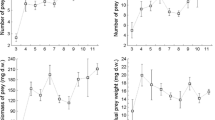Abstract
In 1991 and 1992 Common and Arctic Terns differed in chick-feeding and chick-rearing strategies. Arctic Terns favoured smaller prey, primarily crustaceans, for feeding their chicks than did Common Terns. Consequently, Arctic Tern feeding rates were higher. The influence of the tide on food parameters was greater in Arctic Terns. In both years breeding success was better in Common Terns.
Similar content being viewed by others
Literatur
Ashmole, N. P. (1968): Body size, prey size, and ecological segregation in five sympatric tropical terns (Aves: Laridae). Syst. Zool. 17: 292–304.
Becker, P. H. (1992): Seevogelmonitoring: Brutbestände, Reproduktion, Schadstoffe. Vogelwelt 113: 262–272.
Ders. (1985): Witterung und Ernährungssituation als entscheidende Faktoren des Bruterfolgs der Flußseeschwalbe (Sterna hirundo). J. Orn. 126: 393–404.
Dies. (1986): Die Bedeutung von Nestdichte und Neststandort für den Bruterfolg der Flußseeschwalbe (Sterna hirundo) in Kolonien einer Wattenmeerinsel. Vogelwarte 33: 192–207.
Becker, P. H., D. Frank &U. Walter (1987): Geographische und jährliche Variation der Ernährung der Flußseeschwalbe (Sterna hirundo) an der Nordseeküste. J. Orn. 128: 457–475.
Becker, P. H., D. Frank &S. R. Sudmann (1993): Temporal and spatial pattern of common tern (Sterna hirundo) foraging in the Wadden Sea. Oecologia 93: 389–393.
Becker, P. H., &R. Specht (1991): Body mass fluctuations and mortality in Common TernSterna hirundo chicks dependent on weather and tide in the Wadden Sea. Ardea 79: 45–56.
Bezzel, E. (1985): Kompendium der Vögel Mitteleuropas. Band 1: Non-Passeriformes. Wiesbaden.
Boecker, M. (1967): Vergleichende Untersuchungen zur Nahrungs- und Nistökologie der Flußseeschwalbe (Sterna hirundo L.) und der Küstenseeschwalbe (Sterna paradisaea Pont.). Bonn. zool. Beitr. 18: 15–126.
Cezilly, F., &J. Wallace (1988): The determination of prey captured by birds through direct field observations: a test of the method. Colonial Waterbirds 11: 110–112.
Chapdelaine, G., P. Brousseau, R. Anderson &R. Marsan (1985): Breeding ecology of Common and Arctic Terns in the Mingan Archipelago, Quebec. Colonial Waterbirds 8: 166–177.
Courtney, P. A., &H. Blokpoel (1980): Food and indicators of food availability for common terns on the lower Great Lakes. Can. J. Zool. 58: 1318–1323.
Cramp, S. (1985): Handbook of the Birds of Europe, the Middle East and North Africa. Vol. 4. Oxford, N. Y.
Dierschke, V., &H. Klümann (1988). Zur Nahrung nestjunger Küstenseeschwalben (Sterna paradisaea) im Naturschutzgebiet Oehe-Schleimünde. Seevögel 9: 26–27.
Duffy, D.C., &S. Jackson (1986): Diet studies in seabirds: a review of methods. Colonial Waterbirds 9: 1–17.
Dunn, E. K. (1972): Studies on terns with particular reference to feeding ecology. Ph. D. thesis, Univ. Durham.
Erwin, R. M. (1977): Foraging and breeding adaptations to different food regimes in three seabirds: The Common Tern,Sterna hirundo, Royal Tern,Sterna maxima, and Black Skimmer,Rynchops niger. Ecology 58: 389–397.
Ewins, P. J. (1985): Growth, diet and mortality of Arctic TernSterna paradisaea chicks in Shetland. Seabird 8: 59–68.
Frank, D. (1990): Fütterrate und Nahrungszusammensetzung von Flußseeschwalben (Sterna hirundo) anhand automatischer Registrierung am Nest. Proc. Int. 100. DO-G Meeting, Current Topics Avian Biol., Bonn 1988: 159–165.
Ders. (1992): The influence of feeding conditions on food provisioning chicks in Common TernsSterna hirundo nesting in the German Wadden Sea. Ardea 80: 45–55.
Ders. &P. H. Becker (1992): Body mass and nest reliefs in Common TernsSterna hirundo exposed to different feeding conditions. Ardea 80: 57–69.
Glasmacher, M. (1987): Nisthilfen für eine niederrheinische Flußseeschwalbenpopulation (Sterna hirundo). Charadrius 23: 183–199.
Glutz von Blotzheim, U. N., &K. M. Bauer (1982): Handbuch der Vögel Mitteleuropas. Band 8/II. Wiesbaden.
Hälterlein, B., &B. Steinhardt (1993): Brutvogelbestände an der deutschen Nordseeküste im Jahre 1991. Fünfte Erfassung durch die Arbeitsgemeinschaft „Seevogelschutz“. Seevögel 14: 1–5.
Hulsman, K. (1987): Resource partitioning among sympatric species of tern. Ardea 75: 255–262.
Lemmetyinen, R. (1973a): Feeding ecology ofSterna paradisaea Pontopp. andS. hirundo L. in the archipelago of southwestern Finland. Ann. Zool. Fennici 10: 507–525.
Ders. (1973b): Breeding success inSterna paradisaea Pontopp. andS. hirundo L. in southern Finland. Ann. Zool. Fennici 10: 526–535.
Massias, A., &P. H. Becker (1990): Nutritive value of food and growth in Common TernSterna hirundo chicks. Orn. Scand. 21: 187–194.
Mes, R., &R. Schuckard (1976): Een onderzoek naar verschillen in fourageeractiviteit tussen VisdiefSterna hirundo en Noordse SternSterna paradisaea op de Engelmansplaat (NL). Versl. techn. geg. Inst. Taxon. Zool. Rep. 11: 1–36.
Monaghan, P., J. D. Uttley &M. D. Burns (1992): Effect of changes in food availability on reproductive effort in Arctic TernsSterna paradisaea. Ardea 80: 71–81.
Monaghan, P., J. D. Uttley, M. D. Burns, C. Thaine &J. Blackwood (1989): The relationship between food supply, reproductive effort and breeding success in arctic ternsSterna paradisaea. J. Anim. Ecol. 58: 261–274.
Neubauer, W. (1990): Die Nahrung nestjunger Flußseeschwalben am Krakower See. Acta ornithoecol. 2: 171–179.
Pearson, T. H. (1968): The feeding biology of seabird species breeding on the Farne Islands, Northumberland. J. Anim. Ecol. 37: 521–552.
Sagar, P. M. (1991): Aspects of the breeding and feeding of Kerguelen and Antarctic terns at the Kerguelen Islands. Notornis 38: 191–198.
Stienen, E. W. M., &P. G. M. van Tienen (1991): Prooi- en energieconsumptie door kuikens van noordse stern (Sterna paradisaea) en visdief (Sterna hirundo) in relatie tot enkele abiotische factoren. Intern rapp. 91/32. Rijksinst. Naturbeheer, Arnhem.
Südbeck, P., &B. Hälterlein (1994): Brutvogelbestände an der deutschen Nordseeküste im Jahre 1992. Sechste Erfassung durch die Arbeitsgemeinschaft „Seevogelschutz“. Seevögel 15: 11–15.
Voous, K. (1962): Die Vogelwelt Europas. Hamburg.
Wiggins, D. A., &R. D. Morris (1987): Parental care of the Common TernSterna hirundo. Ibis 129: 533–540.
Author information
Authors and Affiliations
Rights and permissions
About this article
Cite this article
Frick, S., Becker, P.H. Unterschiedliche Ernährungsstrategien von Fluß- und Küstenseeschwalbe (Sterna hirundo undS. paradisaea) im Wattenmeer. J Ornithol 136, 47–63 (1995). https://doi.org/10.1007/BF01647207
Published:
Issue Date:
DOI: https://doi.org/10.1007/BF01647207




